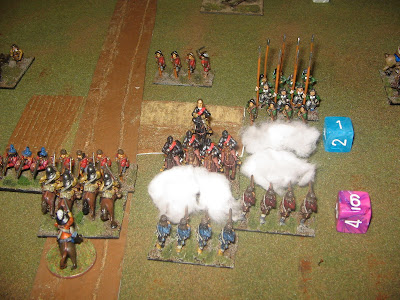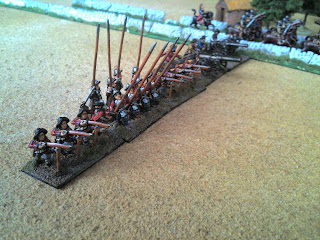One month after the opening skirmish at Powick Bridge, King Charles' army found itself facing a Parliamentarian army under Robert Devereux, the 3rd Earl of Essex, in Warwickshire. Charles had deployed his force on the escarpment of
Edgehill, blocking Essex's march into Oxfordshire to relieve Banbury.
 |
Origin: Beesley, 1841, History of Banbury
reproduced at http://www.battlefieldstrust.com/ |
Essex deployed among the hedgerows and fields of the Vale of the Red Horse, below Edgehill, taking advantage of the cover to protect both flanks. The Parliamentarians stood firm in their defensive posture through that fateful Autumn morning encouraging the King to march his men down onto the flats to force an engagement. The simple farming folk of Radway abandoned their fields that day, choosing rather to seek what shelter and comfort they could find ... be it Inn or Kirk!
 |
Charles I holds a council of war on the eve of the battle of Edgehill
By Charles Landseer, 1799-1879 |
Here begins the second encounter of this DBA-RRR 1642 mini campaign (and here we depart from the historical record!).
The Parliamentarian foot outnumbered their Royalist counterparts and were better disciplined and well led. Charles knew his best hope lay in breaking Essex's line with a spirited charge of his cavaliers. After the Parliamentarian victory at the skirmish at Powick Bridge, Prince Rupert of the Rhine had his reputation to recover. Rupert's loss of mounted troops at Powick Bridge had been double that of the Parliamentarians and he had only managed to recover half of that number in the month that followed (thus the King deploys 11 elements). Parliament, however, came to Edgehill at full strength (12 elements). Unlike his historical counterpart, this time Charles decides not to spend the morning on the escarpment awaiting Essex's attack, but marches down early into the fields of the Vale to take advantage of the hedges and enclosed fields to protect his flanks.
 |
| Deployment: The King's army arrayed for battle in the foreground |
Charles deployed with his dragoons (x1) on his left, a block of foot (2 x pike, 3 x shot) in this centre and the full weight of his mounted troops under Rupert's command on the right (4 x Knight). The King deployed in reserve with his lifeguard (1 x pistols). Essex deployed to the Parliamentarian right with his artillery (1 x cannon) flanked by his cavalry (1 x Cv) and pistols (1 x Pi). In the centre was a block of foot (2 x pike, 2 x shot) with a column of shot (3 x Sh) and cavalry to the rear.
 |
| Rupert seizes the initiative on the Royalist right |
As the foot of both armies cautiously formed lines of battle, Prince Rupert sought to gain the initiative with an daring charge on the unprotected Parliamentarian left flank. Essex ordered up his cavalry reserve to secure his left while advancing his shot and artillery on his right. Essex's tercio in the centre stood firm behind the ploughed fields to their front (bad going, in this game).
Essex's cavalry arrived in time to secure his left and as the King's cavaliers thundered over the field towards the Parliamentarian left. The centre wheeled to threaten Rupert's left flank. As Charles ordered his pistols forward to counter this threat, a sound like rolling thunder informed him that Essex's gunners have found their first targets among the straggling foot on the Royalist left. Rupert's troopers charged into contact as the first salvo from the Parliamentarian musketeers finds its mark.
 |
| The opening shots |
Rupert orders his troopers to expand their line to contact the Parliamentarian foot and cavalry to the right of the ploughed fields. The lines collide with a sickening crash of flesh and steel, and despite their momentum, the cavaliers can't shake the Parliamentarian tercio. The pike deployed in depth in the centre obliterate the hapless left of Rupert's line, and, with muskets clubbed, the musketeers fight off the determined charge. Essex's cavalry also recoil their attackers on their far left but in the centre the cavaliers strike deep, sweeping away an entire regiment and exploiting the gap in Essex's line.
The fresh Parliamentarian shot advance through the ploughed fields threatening to overpower the weakened Royalist left and Essex leads his pistols up the road in the centre trying to regain the initiative. On the right, Rupert's flank is in disarray, but by no means beaten.
As the Parliamentarian centre advances, Essex is forced to order the shot on his left to fall back behind the pike block to protect its rear from the reforming Royalist horse. Observing this weakening of the defensive posture in the centre, Rupert orders his troopers to ride down the shot, and they are swept away while the remaining cavaliers converge on the now isolated troopers on the Parliamentarian left.
Essex's left flank collapses and sensing the immanence of his defeat, he leads a desperate charge in the centre supported by his musketeers, hoping to break the Royalist line at its weakest point. Musketry thunders across the Vale of the Horse, flesh feels the terrible bite of hot lead, and eyes on both sides stream from this burning devils breath.
Charles leads his lifeguard into the fray to allay the threat in his centre – the pistols of his heavy cavalry discharge in the faces of the of Parliamentarian musketeers who have hastily formed ranks the ploughed field ... despite this onslaught, they hold! At that very moment, Essex is leading his own desperate charge hoping to sweep away the musketeers on the Royalist centre left. As his cuirassiers pound in, Charles' musketeers give fire and give Essex's men some hot stuffe ...
Charles' musketeers found their mark and obliterated their Parliamentarian counterparts on Essex's left. Essex found himself dangerously exposed by the utter destruction of his left flank. Fully one third of his men lay smashed and bleeding on the fields beneath Edgehill. The resolve of his men was broken and they fell back in disorder.
Likewise, King Charles' men, few of them having tasted battle before, showed little taste for further slaughter and withdrew to count the cost of this first serious engagement of the Civil War. It would be a cold night for the survivors and wounded of both armies, left to find what shelter and help they could, with empty stomaches turned by the experience of death at close quarters.
"No man nor horse got any meat that night and I had touched none since the Saturday before ... neither could I find my servant who had my cloak so that having nothing to keep me warm but a suit of iron [armour] I was obliged to walk about all night which proved very cold by reason of the sharp frost."
Edmond Ludlow, Officer of Essex's Lifeguard at Edgehill*
*In, Trevor Royle, Civil War: The Wars of the Three Kingdoms 1638–1660 (Abacus, London, 2004) p. 199
Final result:
- Royalists lost 1 x Kn (1)
- Parliamentarian lost 2 x Cv, 2 x Sh (4)
On to Brentford!





















































